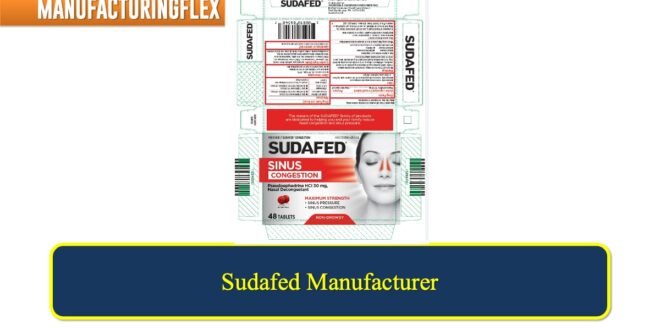Sudafed, a well-known brand of oral decongestants manufactured by Johnson & Johnson, plays a significant role in the booming market for these drugs. With an estimated value of $2.2 billion, this industry showcases the widespread demand for medications that provide relief from nasal congestion. However, beyond its financial success, Sudafed’s popularity can be attributed to its effectiveness and versatility.
What sets Sudafed apart from other decongestants is its active ingredient: pseudoephedrine. This compound works by narrowing blood vessels in the nasal passages, reducing swelling and congestion. Moreover, Sudafed is available over-the-counter, making it easily accessible to people seeking immediate relief from stuffy noses or sinus pressure. Its efficacy has made it a go-to solution for individuals battling allergies or common cold symptoms.
Despite its widespread use, however, Sudafed does come with some caveats that should not be overlooked. One major concern associated with this medication is the potential for abuse due to pseudoephedrine’s stimulant properties. In response to this issue, regulations have been implemented to limit access to large quantities of Sudafed and similar drugs in order to prevent their diversion into illegal production of methamphetamine. These precautions highlight the need for responsible consumption and effective pharmacovigilance when using such medications.
Phenylephrine, a common ingredient found in many over-the-counter cold and sinus medications, has long been touted as an effective treatment for nasal congestion. However, recent findings from FDA experts have deemed this drug to be ineffective in relieving congestion symptoms. This revelation is alarming considering that products containing phenylephrine make up about four-fifths of the market.
With so many consumers relying on these medications to alleviate their discomfort, it is disconcerting to discover that the active ingredient may not actually provide any relief. This begs the question: why are so many products still formulated with phenylephrine? Is it simply a case of manufacturers being slow to adapt or are there deeper factors at play?
One possible explanation could be that phenylephrine is a cheap and easily accessible ingredient for manufacturers. The cost-effectiveness of using this drug may outweigh concerns about its efficacy. Additionally, companies may already have established supply chains and production processes in place for phenylephrine-based formulations, making it difficult or costly to switch to alternative ingredients.
As consumers become more informed about the effectiveness of cold and sinus medications containing phenylephrine, they are likely to seek out alternatives that offer real relief. This shift in consumer demand could force manufacturers to reevaluate their product formulations and invest in research for more effective remedies. In turn, this could pave the way for innovative solutions that truly address the needs of those suffering from nasal congestion.
What are the other brands of Sudafed Manufacturer?
Pseudoephedrine, commonly known by its brand name Sudafed, is a popular over-the-counter decongestant used to relieve nasal congestion. While Sudafed might be the most well-known brand of pseudoephedrine, there are several other options available in the market that offer similar relief. One such alternative is Galpseud, which contains the same active ingredient as Sudafed and provides effective relief for blocked noses. Another option is Boots Decongestant, produced by the reputable pharmaceutical company Boots, which has a long-standing history of manufacturing high-quality medicinal products.
Care Decongestant is yet another brand that offers pseudoephedrine-based medication to combat nasal congestion. What sets Care Decongestant apart from others is its focus on delivering affordable yet reliable decongestion solutions to consumers. As more individuals seek accessible healthcare options without compromising on quality, Care Decongestant has become a go-to choice for many. While all these brands contain pseudoephedrine as their active ingredient and aim to provide relief from nasal congestion symptoms, it’s important to note that individual preferences may vary. It’s always advisable to consult a healthcare professional or pharmacist before choosing one particular brand over another based on factors such as efficacy and potential side effects.
Sudafed taken off the market
The passage of the Combat Methamphetamine Epidemic Act of 2005 had a significant impact on drugmakers and the production of popular products like Sudafed. With pseudoephedrine, the primary ingredient in Sudafed, now available only behind the counter, pharmaceutical companies were forced to find alternative solutions. Enter phenylephrine. This nasal decongestant became the go-to replacement for pseudoephedrine in over-the-counter cold and allergy medicines.
But here’s the catch – phenylephrine is not as effective as pseudoephedrine in alleviating nasal congestion. Studies have shown that it lacks the potency and efficacy necessary to provide relief for severe stuffed noses. So while keeping Sudafed on store shelves was important due to its widespread use by consumers, its effectiveness could be compromised when swapped with phenylephrine. This led some physicians and medical professionals to question whether this substitution truly served patients’ best interests or if it just made complying with legal regulations easier for drug manufacturers.
In conclusion, after new restrictions were placed on the availability of pseudoephedrine due to concerns about methamphetamine production, drugmakers turned to phenylephrine as a substitute ingredient in products such as Sudafed. However, this switch came at a cost: decreased effectiveness in relieving nasal congestion compared to its predecessor. As consumers continue their quest for effective relief from cold and allergy symptoms, it remains essential for both pharmaceutical companies and regulatory bodies alike to strike a delicate balance between ensuring public safety.
